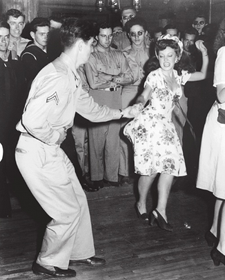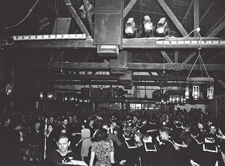Book reveals more complicated picture of nostalgic WWII Hollywood Canteen nightclub
LAWRENCE — For many, the Hollywood Canteen nightclub represents the American home front during World War II at its feel-good best. Many a homefront documentary or exhibit includes photos and film clips of celebrity volunteers, such as Marlene Dietrich, Lana Turner and Rita Hayworth, washing dishes, making sandwiches and jitterbugging with the enlisted men.
 There are other features to admire about the Hollywood Canteen. Actress Bette Davis, the Canteen president, along with other volunteers, fought for the club to be racially integrated and pledged to quit when that policy was threatened.
There are other features to admire about the Hollywood Canteen. Actress Bette Davis, the Canteen president, along with other volunteers, fought for the club to be racially integrated and pledged to quit when that policy was threatened.
Yet in a new book, a University of Kansas professor reveals a more complicated picture of the place where movie stars danced with the GIs. She does so through interviews with a diverse group of people who described their experiences of the Los Angeles nightclub in many different ways.
“Most of the white people I interviewed remembered a racially integrated place, and most of the people of color remembered a segregated or partially segregated place,” said Sherrie Tucker, professor of American studies.
Additionally, most people remembered women in uniform being welcome, except, said Tucker, “the servicewomen, most of whom remember not being allowed on the dance floor, but sent to a tiny room upstairs where they could watch the fun.”
 In "Dance Floor Democracy: The Social Geography and Memory at the Hollywood Canteen," released this month by Duke University Press, Tucker draws from extensive archival research and interviews with people of different races, ethnicities, sexes and sexual orientations, military status and political affiliations in order to explore the contradictions bound up in what she says is a lingering nostalgia for World War II.
In "Dance Floor Democracy: The Social Geography and Memory at the Hollywood Canteen," released this month by Duke University Press, Tucker draws from extensive archival research and interviews with people of different races, ethnicities, sexes and sexual orientations, military status and political affiliations in order to explore the contradictions bound up in what she says is a lingering nostalgia for World War II.
“The point is not to debunk the Hollywood Canteen,” Tucker said. “This is not an exposé. I’m interested in nostalgia and its power. For me, that means exploring its contradictions. I wanted to have conversations with people who had danced at the most nostalgia-drenched place I could find, and I wanted to find out how people from different communities talked about their memories of this place.”
 Tucker aims to write about contradictory memories in ways that are respectful of many different experiences, perceptions, memories and stories.
Tucker aims to write about contradictory memories in ways that are respectful of many different experiences, perceptions, memories and stories.
“We can learn a lot from listening better to many perspectives at once, instead of squeezing them out of national memory or using one set of memories to discredit another. I am very fortunate to have met so many interesting people of a diverse and complex generation who had a lot of interesting things to say about that and all kinds of other things. They talked about having the time of their life, or being left out, or feeling scared or sad. People talked about freedom and restrictions and everything in-between. They talked about wars of the present. Most of them have passed since our interviews.”
Tucker’s first book, "Swing Shift: ‘All-Girl’ Bands of the 1940s," released in 2000, also explored little-known aspects of big band music of the World War II era. It was while writing "Swing Shift" that Tucker realized that she needed to do a second book in which she got off the bandstand and wrote about the dancers.
Aside from documenting the popularity of swing dancing, and interviewing dancers, Tucker also uses dance as a metaphor in the book.
“That's why it’s called ‘Dance Floor Democracy.’ Instead of the bird's-eye view, I wanted to listen to dancer, after dancer, after dancer, and try to imagine moving on the dance floor from that perspective. Jitterbugging on a crowded dance floor; it’s all about sharing weight, equally or not equally, falling, flying, moving with and against other people," she said. "‘Dance Floor Democracy’ is a concept that tries to get at more embodied and accountable ways of thinking about democracy, swing and the powerful nostalgia for better wars and greater generations; all those contradictions that we are still dancing with.”